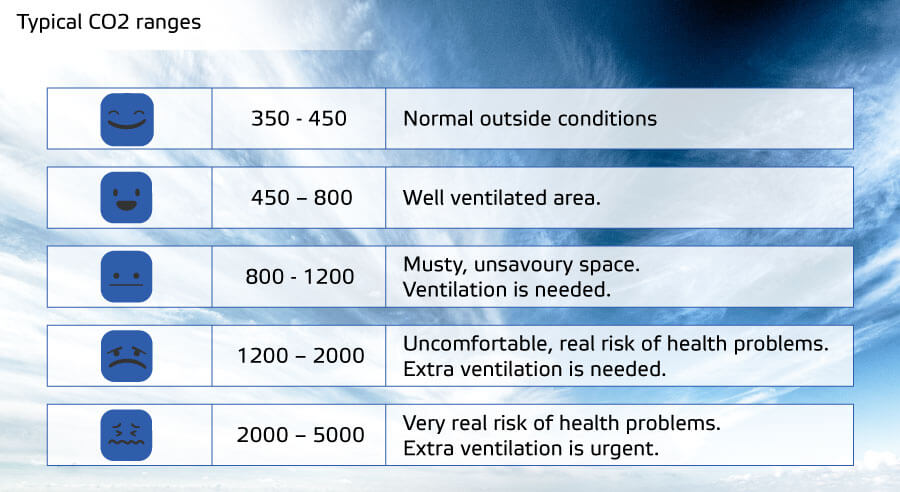Why measure CO2?
Demand-controlled ventilation based on CO2 measurements
Demand-controlled ventilation systems use CO2 concentrations within a building to know whether adequate fresh air needs to be supplied to a space. Ventilation systems that are controlled based on the measured CO2 level can control fresh air supply depending on the occupants and their activity level. Sentera’s broad range of CO2 sensors are a great option for your application. Ventilation based on CO2 level is especially interesting in rooms where there are many fluctuations in usage, such as meeting rooms, classrooms, universities, etc.
View our demand-based CO2 solutions on our Solutions page.
What is Carbon Dioxide?
Carbon Dioxide or CO2 is a compound that is a by-product of metabolic processes in living organisms and combustion. It is, on a chemical level, a combination of oxygen and carbon. Humans produce CO2 when breathing. Therefore, CO2 is an air pollutant very often associated with humans in indoor environments.
Carbon Dioxide as a toxin
High CO2 levels can be dangerous in and of themselves. Moderate to high levels of carbon dioxide can cause headaches and fatigue, and higher concentrations can cause nausea, dizziness, and vomiting. Loss of consciousness can occur at extremely high concentrations. To prevent or reduce high concentrations of carbon dioxide in a building or room, fresh air must be supplied to the room.
Carbon Dioxide as an indication of room use
CO2 is a great indicator of how many people are together in a room. Carbon dioxide in a room is mostly a result of human metabolism. CO2 concentrations within a building indicate fairly well how much people are using a room. It is important to monitor, as high CO2 concentrations can signify that there is not too much good air left in a room and toxins, like VOCs and disease-spreading particles, have been building up.
Carbon Dioxide and disease spreading
When an ill person uses a room, infectious particles will be present there. As we established earlier, these particles can build up over time. The more of these particles are present, the higher the risk of transmission and infection of disease. We cannot possibly measure all particles that can spread disease in a room. However, if a person were to be ill, the CO2 level correlates with the chance they spread the disease. With demand-controlled ventilation based on CO2 measurements, people who can transmit diseases but are not affected by them, are less likely to spread the disease.
CO2 - NDIR CO2 sensing technology
NDIR is an industry term for “nondispersive infrared”, and is the most common type of sensor used to measure CO2. CO2 gas molecules absorb the specific band of IR light while letting other wavelengths of light pass through. The remaining light goes towards an IR detector, which is located behind an optical filter. The optical filter also blocks out some of the light. The IR detector reads the amount of light that was not absorbed by the CO2 molecules or the optical filter. The difference between the amount of light radiated by the IR lamp and the amount of IR light received by the detector is measured. The difference is proportional to the number of CO2 molecules in the air inside the room.
Limit values for CO2
The ranges of Sentera CO2 sensors are adjustable. The following values are often used. We recommend keeping the CO2 concentration in a room below 800 ppm. Do not try to get the CO2 concentration below 400 ppm, as that is the normal level in outdoor air. In greenhouses, however, CO2 levels should be kept higher to foster plant growth.

